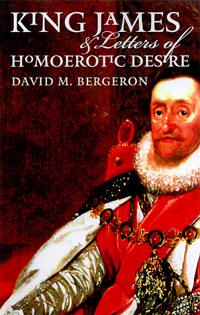 |

 |
|
of Homoerotic Desire King James & Letters of Homoerotic Desire by David M. Bergeron, University of Iowa Press, 1999 251 pages, ISBN: 0877456690
 The first edition of the English Bible commonly known as the "King James Version" was printed in 1611. King James VI & I of Great Britain had sponsored the project, and the translators appropriately dedicated the new Bible to him.
The first edition of the English Bible commonly known as the "King James Version" was printed in 1611. King James VI & I of Great Britain had sponsored the project, and the translators appropriately dedicated the new Bible to him.
At this point in his own personal life, King James had already been involved in a love affair with one man, the Duke of Lennox, which provoked a rebellion in Scotland; his current lover in England was a young man whose special relationship with the king would earn him the Earldom of Somerset. By 1615, however, Somerset's fortunes declined and James succeeded in luring his most famous lover, George Villiers, later Duke of Buckingham, into bed. What are we to make of these relationships between King James and his so-called "favorites?" Many earlier historians treated the subject with shock, disdain, and denial. Only recently has the subject been treated more seriously and fairly by scholars such as Caroline Bingham, Jonathan Goldberg, Roger Lockyer, and David Bergeron. Bergeron's latest book on the subject is an event to be celebrated. It provides the full text of the letters written between James and his favorites, letters that reveal the undeniably homoerotic nature of these relationships. Bergeron acknowledges his indebtedness to earlier editors of some of these letters, most notably G. P. V. Akrigg and Hugh Ross Williamson, but it is Bergeron's signal achievement to bring all these letters together, correcting occasional errors and augmenting them with extended analysis. All future researchers will be indebted to him for this sterling achievement. The core of the collection is a series of letters written between James and Buckingham in 1623 when they were separated because the Duke was in Spain. As Bergeron justifiably observes, these letters "document love and desire more clearly than any other body of kingly correspondence in England's early modern period" (p. 126).
Readers may question the relevance of the introductory chapter, but there is no doubt that the biographical chapters, which quote extensively from the correspondence, are integral to the book and insightful. Bergeron is especially perceptive when discussing the tenor of James's emotional life and providing his own textual analysis of the letters. Compared to the magnitude of his achievement, criticisms of Bergeron's book are minor. First, he likes to quote the vivid words of later writers such as John Hacket, Michael Sparke, and Arthur Wilson, but he does not always clarify the motives of these writers and whether they actually witnessed the events they described. Quotability sometimes seems more important than reliability. Secondly, the necessity to move back and forth between a narrative of events and analysis of letters sometimes leads to chronological confusion, especially in the chapter on Somerset. Thirdly, although desire is fashionable these days, and desire can certainly be documented where sex cannot, still the relentless focus on "homoerotic desire" in this book leads occasionally to strained interpretations and ambivalence on the issue of physical sex. Finally, while the sensitivity and sympathy that Bergeron brings to his subject are surely preferable to the rank prejudice that colored previous accounts, the lasting impression he gives of James and his lovers may in the end be too sentimental. Reviewers sometimes criticize a book for what it does not contain rather than what it does contain. Bergeron, a professor of English, understandably stays pretty tightly within the narrowly circumscribed world created by his texts. The book, as the title states, is about "letters of homoerotic desire." Bergeron makes little effort to go outside the confines of these letters and gauge the public reaction to James's homoerotic relationships. He does not even attempt to situate James's case within the longer history of homosexuality. Yet Bergeron has written an excellent book on the subject as he defines it. And I confess that I find myself both delighted and relieved that he has defined his subject so narrowly. I hope it will not appear to be an act of shameless self-promotion for me to mention here that my own forthcoming book on King James deals precisely with the issues left out of Bergeron's book. Of course I leave it to others, perhaps Bergeron himself, to review the quality of my efforts, but at the very least our two books fortuitously complement each other. By the end of 1999 we will know much more than ever before about the (homo)sexuality of the man for whom the "King James Version" of the Bible is named. 2000 Review by: Michael B. Young of Illinois Wesleyan University This review is reprinted with permission from The Newsletter of the Committee on Gay and Lesbian History Vol. 12 No. 3 (Fall 1999) courtesy of the International Gay & Lesbian Review: www.usc.edu/Library/oneigla/onepress |
 © 1997-2000 BEI
© 1997-2000 BEI